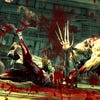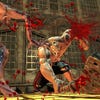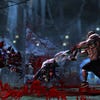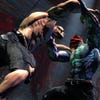Splatterhouse
Schlock tactics.
The emphasis is always on violence and gore. "The key is blood, Rick," says the mask, whose growling commentary is a permanent fixture inside your head, when you first encounter a locked door. "It's always blood."
When enemies reach their last slither of health, you can unleash a finishing move that prompts you to push or pull the analogue sticks in directions that correspond to whatever Rick is doing with his hands - crushing a skull, pulling upper and lower jaws apart and then ripping the lungs up through a dying monster's throat, or perhaps yanking its arms backward until they are wrenched out of their sockets.
Level design is rudimentary and old-fashioned. You're often trapped in a room until you have killed enough enemies, either directly or by impaling them on some ghastly contraption, and the only changes in pace are awkward platform sequences and 2D side-scrolling sections heavy on environmental traps. Both are too full of instant and sometimes unavoidable deaths to be anything other than frustrating diversions, while bosses are often huge but seldom interesting in any other way.
But then, Splatterhouse isn't designed to impress on these levels - it wants to live or die on its exploitative, trashy style and escalating, comical levels of violence. And so you open doors by throwing enemies into grinders to fill cylinders with liquefied meat, and rip the heads off monsters and impale them on spikes to activate switches, while the collectable items hidden around levels are photos of your kidnapped girlfriend posing naked.
As the mask goads Rick into killing, it's really talking to us. "Hey, a 2x4, let's do some carpentry..." it says, or, more directly, "Let's show them why they call it Splatterhouse." At one stage, as you turn some knee-high monsters inside out using an industrial microwave, he says, "This sort of s*** is why we got an R rating."
But for all the impalement, decapitation, arms being pulled out of sockets and fountains of gore, Splatterhouse is only reasonably good at being the classless procession of shock and bad taste that it wants to be, for the simple reason that we have moved on from that parental advisory notice, handed down for "some questionable enemies" all the way back in 1990. The Corrupted are neither man nor beast, nor particularly gruesome, and after 30 seconds or so carving them up, their deaths - agonising or otherwise - are really not that much more shocking than jumping on a Goomba's head or shooting a Space Invader.
If you want players to gasp, frown and delight in the guilty pleasures of shocking violence these days, it's not enough to do have us slice up ugly brown lumps that bear no resemblance to anything. You need to taunt, degrade and humiliate. You need us to recognise what things are or what they used to be. (And while you're playing Dante's Inferno for inspiration, have a look at the combat system and level design too, please?)
It's a measure of how far we've come that just over 20 years ago the sight of blood alone was enough to shock and offend, whereas now it is nowhere near enough. Sadly though, it's also a measure of how little Splatterhouse has advanced that its guilty pleasures are too tame and abstract to match even that achievement, while the game underneath is too generic and rough around the edges to compensate for its other shortcomings.
















